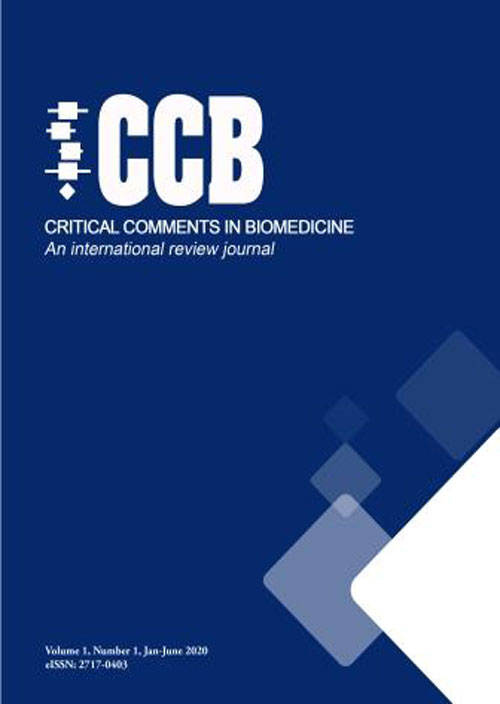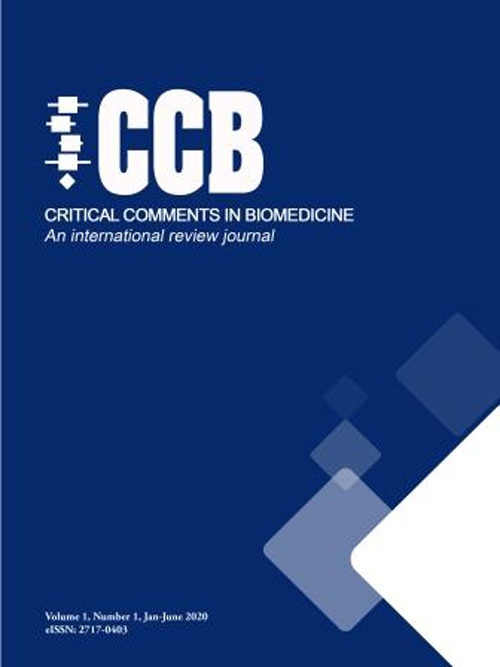فهرست مطالب

Critical Comments in Biomedicine
Volume:2 Issue: 2, Summer-Autumn 2021
- تاریخ انتشار: 1400/07/25
- تعداد عناوین: 7
-
-
Page 3Background
Diabetes is one of the most serious health challenges of the 21st century. The number of adults with diabetes has roughly tripled in the last 20 years. The increased burden of chronic diseases and scarce health resources compel healthcare systems to make modern patients more self-sufficient by requiring them to play a more active part in the treatment and management of their disease. Tele-home-care is a method of distance intervention through the transmission of electronic data for follow-up, education, prevention, clinical decision-making, and treatment modulation that has a high potential for the population with diabetes. Previous studies have not systematically evaluated the effects of different features of long-distance caregiving on diabetes at different stages of disease severity.
ObjectivesThe present study describes a protocol for a systematic review and meta-analysis for summarizing the evidence comparing telehomecare interventions on diabetes management and its complications.
MethodsPubMed, Scopus, ISI Web of Science, Cochrane databases, HTA (Health Technology Assessment), NHS EED (NHS Economic Evaluation Database), DARE (Database of Abstract of Reviews of Effects), Embase, and SID will be searched using medical subject heading (MeSH) keywords. Controlled clinical trials in patients with type 1 diabetes, type 2 diabetes, and gestational diabetes will be selected based on predefined eligibility criteria. The risk of bias in studies will be checked using the JADAD score. The mean difference and its standard deviation will be calculated to be used as effect size. A random-effects meta-analysis was performed to pool the results. Subgroup analysis and meta-regression will be conducted to explore the possible sources of heterogeneity.
ConclusionThe systematic review and meta-analysis provided by the results of a systematic review can be useful to endocrinologists, physicians, public health policymakers, and the general population.
Keywords: Tele-homecare, Diabetes, Systematic review, Meta-analysis -
Page 4Background
Sampling methods are one of the main components of each research. Familiarity with a variety of sampling methods is essential for researchers.
ObjectiveThe main purpose of this study was to teach different probabilistic and non-probabilistic sampling methods to improve the knowledge of researchers in conducting more accurate research.
MethodsIn this tutorial article, useful information about each sampling method, as well as how to properly use each method and its strengths and weaknesses were provided.
ResultsFive cases of probabilistic sampling methods and four cases of non-probabilistic sampling methods that are common were taught. Probabilistic sampling included simple random sampling, stratified random sampling, cluster sampling, systematic random sampling, and multi-stage random sampling. In addition to introducing each method, its strengths and weaknesses were also mentioned.
ConclusionProbabilistic sampling methods despite limiting assumptions provide more reliable results. Therefore, if it is possible, researchers should use probabilistic sampling methods for the accuracy of the study.
Keywords: Sampling, Probability Samples, Sampling Study -
Page 5Background
Chronic obstructive pulmonary disease (COPD) is considered the fourth main cause of mortality worldwide, affecting 10% of adults aged up to 40 years. Due to the growing elderly population and smoking, the global burden of COPD is expected to increase in the general population. Telemedicine may help patients with COPD to decrease exacerbation episodes and the associated costs. Moreover, Telehomecare (THC) may be considered as an alternative to cut down hospitalization costs and increase the patients’ comfort.
ObjectivesThis study explains the methodology of a systematic review and meta-analysis designed to evaluate the impact of THC interventions on the control and management of COPD and its complications.
MethodsTo review all published studies comparing THC interventions in controlling COPD and its complications, all studies published in PubMed, Google Scholar, Scopus, ISI Web of Science, Cochrane databases, HTA EED, DARE, Embase, SID, Magiran will be searched until the end of 2021. Randomized controlled trials (RCTs), cluster RCTs, controlled clinical trials comparing telehealth with standard monitoring of COPD patients were included. Independent reviewers will review the abstracts and full-texts of all relevant studies for eligibility, risk of bias, and data extraction using structured forms. The meta-analysis will be performed for adequately homogenous studies regarding their populations, interventions, and objectives.
ConclusionThe results of this systematic review and meta-analysis will provide useful information on the impacts of THC on COPD control. The evidence provided by this systematic review can be helpful for clinical specialists, public health policymakers, and the general population.
Keywords: Telemedicine, Chronic Obstructive Pulmonary Disease, Meta-analysis, Systematic review -
Page 6
Coronavirus disease 2019 (COVID-19) is associated with severe multiorgan clinical manifestations. Although respiratory involvement is the predominant manifestation in patients infected with COVID-19, involvement of other organs, such as the nervous system, has also been identified; which highlights the virus' ability to disrupt the organs’ function. There is ample evidence of a nervous system susceptibility to the COVID-19. In this regard, the COVID-19 pandemic effect on psychological health, including insomnia, anxiety, obsessive-compulsive disorder, and depression among health care workers and other high-risk groups has been identified. So far, many studies have examined the psychiatric manifestations in infected patients with COVID-19. Undoubtedly, awareness of these findings can help in the prevention and timely treatment of these patients. This study aimed to review the possible mechanisms ofCOVID-19 neuroinvasive potential, psychiatric manifestations, and the management of mental disorders in infected patients.
Keywords: COVID-19, Mental Disorders, Nervous System -
Page 7Background
Enteral feeding (EF) is the delivery of liquid nutritional support through a tube for hospitalized patients with gastrointestinal dysfunction who are incapable of eating or unable to meet their nutritional requirements via the oral route. Hospitals reports indicate increase interest and demand for blenderized tube feeding (BTF) as an alternative to commercial enteral formulas particularly in families of tube fed children. In particular, by increasing food sensitivity and more complex identification in children, BTF allows families to adjust their diet to their children's needs. This systematic review study aimed to investigate BTF in pediatric patients.
MethodsLiterature search was conducted in four English databases, including Scopus, PubMed, Science Direct, and Google Scholar, using multiple keywords, such as blenderized tube feeding, pediatric, blended formula, homemade enteral nutrition, and children. Out of 103 retrieved articles, 6 were selected and reviewed.
ResultsThe six articles that included the study criteria were reviewed. The results showed that calories were approximately 1kcal/g, protein 13 -22%, fat 30 - 34%, and carbohydrates 45-55%.
ConclusionsThe results indicated that BTF of calories, fat, carbohydrates, and protein is acceptable and can be administered to the pediatric, but due to concerns about calorie deficiency and macronutrients should be under the supervision of a nutritionist. BTFs are a good choice among children; since they can improve gastrointestinal symptoms and are a good option for families who use EF for their children at home. Most pediatric patients use BTFs as a portion of their EF, making it necessary that nutritionists and physicians expand their knowledge related to BTFs to appropriately care for these pediatric patients.
Keywords: Blenderized Tube Feeding, Pediatric, patients, Children, Systematic review


